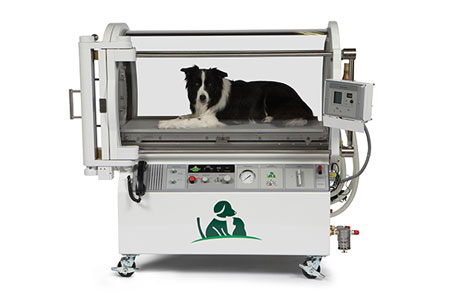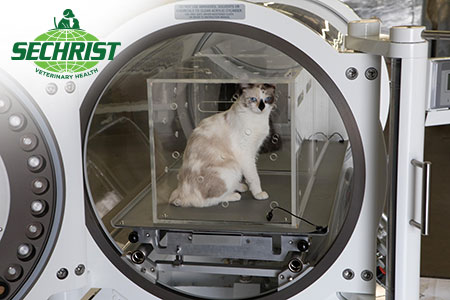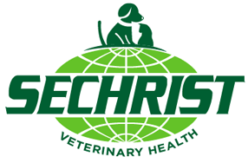Snake bites are a serious concern for pets and pet owners alike, with the potential to cause life-threatening complications. Thankfully, treatment for snake bites has been increasingly successful, , especially with the introduction of groundbreaking hyperbaric animal chambers that can effectively help to promote healing. To find out more about snake bites in pets, and the treatment methods available, please continue reading below.
Signs of snake bites in pets
 There is no way to prevent snake bites in pets entirely – even if your pets are indoors 24/7, there is always a potential for a snake to find its way inside your property and encounter your pet. As a result, pet owners are advised to be aware of the signs and symptoms of snake bites at all times.
There is no way to prevent snake bites in pets entirely – even if your pets are indoors 24/7, there is always a potential for a snake to find its way inside your property and encounter your pet. As a result, pet owners are advised to be aware of the signs and symptoms of snake bites at all times.
Unfortunately, identifying the signs that your pet has been bitten by a snake is often easier said than done. No two snakes are alike; the severity of the bite even within the same species is influenced by the size and maturity of each individual snake. What’s more, bites sustained in summer – when snakes are first emerging from hibernation – can be more severe than bites sustained at other times of the year.
However, while the fact that snake bites can vary significantly makes it more challenging for pets to identify a potential snake bite, there are a few points to keep in mind:
- Swelling. Swelling will usually occur at the location of the bite. In particular, any swollen areas on the head and lower limbs should be a cause for immediate concern.
- Dilated pupils. Your pet’s pupils will often dilate as a result of a snake bite and not contract in response to light.
- Weakness. If your pet is struggling to remain upright or stumbling frequently, this could be a sign of a bite.
- Vomiting. There are numerous reasons your pet may vomit, but if your pet has been outside recently and otherwise seemed well, sudden onset vomiting may indicate a potential snake bite.
- Shaking or twitching. Shaking or twitching of the limbs or head can also indicate a recent bite.
- Paralysis or loss of consciousness. While it is unlikely your pet will become paralyzed or lose consciousness in the immediate aftermath of a snake bite, there is a chance these symptoms may develop a few hours after the bite occurs.
What to do if your pet has been bitten by a snake
 If your pet is showing any signs of a snake bite, then your next step is simple: take your pet to a veterinarian immediately, even if they otherwise seem well. Home remedies are not a reliable choice for snake bites, so always seek professional attention as soon as possible.
If your pet is showing any signs of a snake bite, then your next step is simple: take your pet to a veterinarian immediately, even if they otherwise seem well. Home remedies are not a reliable choice for snake bites, so always seek professional attention as soon as possible.
Upon arriving at your vet’s office, your pet will undergo an assessment to try and ascertain the severity of the bite. At this point, antivenoms may be prescribed and administered if required.
However, antivenoms are an immediate treatment, designed to prevent the venom causing further harm to your pet. As a result, antivenoms are not suitable for long-term treatment and management of recovery. In order to facilitate healing, you may want to consider hyperbaric oxygen treatment for animals.
What is hyperbaric oxygen therapy?
Hyperbaric oxygen therapy – commonly abbreviated as “HBOT” – has long been a beneficial health treatment for humans, with advancements in medicine, hyperbaric technology is now a viable option or pets as well.
HBOT is a relatively simple idea that has nevertheless been shown to be hugely effective. The therapy is designed to stimulate the natural healing processes by allowing an individual – or animal using HBOT for pets – to inhale 100% oxygen. HBOT is delivered in a sealed, high-pressure chamber,allowing your pet to rest comfortably without the need to wear a mask during treatment.. Instead, they are safely secured inside a hyperbaric animal chamber, and can then lie down and breathe normally. Furthermore, the fact that the chambers are see-through allows the pet to be viewed and monitored at all times during the treatment, which helps to ensure both treatment efficacy and comfort for your pet.
How hyperbarics is saving pets

HBOT for pets has been proven to be incredibly beneficial for a range of health conditions, including – but not limited to – the following:
- Feline polyradiculoneuritis
- Baclofen toxicity
- Canine pancreatitis
- Thermal burns
- Septic peritonitis
- Tooth root abscesses
- Delayed wound healing
- Severe tissue trauma…
- … and many more
Importantly, HBOT for pets has also been shown to help resolve injuries caused by snake bites.
Rusty’s case study: HBOT for a rattlesnake bite
Rusty, a Jack Russell terrier, was initially treated with antivenom and plasma for a rattlesnake bite at an emergency care center. Rusty had developed a severe swelling at the site of the bite below his neck. At first, surgical options were considered, until Rusty’s owner requested a second opinion. This second opinion led to Rusty being referred for HBOT; within three days of treatment, the swelling had almost entirely vanished.
Rusty’s case demonstrates the benefits of injury recovery with hyperbarics for pets. Without HBOT, Rusty’s snake bite would have resulted in a long process of surgical recovery in addition to the initial antivenom treatment he received. However, thanks to HBOT for pets, Rusty was able to recover quickly and effectively without the need for further intervention.
How can you access veterinarian hyperbaric treatment for snake bites?
While HBOT for pets has been shown, on numerous occasions, to be hugely advantageous for pets, hyperbaric animal chambers are not yet widespread. You, therefore, may need to travel to a specialist vet to access the treatment. Alternately, you may wish to discuss hyperbarics and the potential for hyperbarics with your vet, refer them to Sechrist Veterinary Health for more information.
In conclusion
If your pet sustains a snake bite, seeking immediate veterinary assistance is always recommended. After initial antivenom treatment, it is well worth pursuing options for veterinarian hyperbaric treatment. As Rusty’s case demonstrates, HBOT for pets can help avoid the need for further surgeries, and allow your pet to get back to their best as soon as possible.
